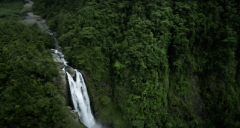FROM LUXURY DAILY | FROM SATRAH JONES | JANUARY 5, 2017
France’s Chanel is exploring the anti-aging secrets of three far-flung populations with a shared claim.
The beauty brand’s newly released Blue Serum took inspiration from Blue Zones around the world, places where the locals live remarkably longer lives. In an effort to prove the claims of its product, Chanel is inviting consumers to journey to these locales in a series of short films.
Chanel was reached for comment.
FEELING BLUE
Chanel’s Blue Serum is being touted by the brand as “a new horizon for skincare.”Explaining the inspiration and ingredient sourcing for this serum, Chanel filmed travel diaries to the Blue Zones that contributed to the product.
Against footage taken in Costa Rica, a female narrator says, “You can feel the life force in everything and everywhere.” Portraying this energy are images of waterfalls amid greenery.

Still from Chanel's Blue Serum film
The voiceover explains how Costa Rica’s green coffee can only be found in the country, which may contribute to the locals’ long lives.
In Italy, the Mediterranean locale is said to be the home of centuries’ old olive trees.
Chanel turns its attention to the sun in Greece, which it says is in everything. This includes soil, plants and the lentisk tree.

Discover the Power of Blue Serum - Chanel
All videos include the statement, “It’s something special. Some call it a mystery. It’s just life.”
These ingredients—sourced from Nicoya, Costa Rica; Sardinia, Italy and Ikaria, Greece, all hold antioxidant properties. According to the brand, a trial found the serum to reduce wrinkles, even skin tone and firm skin.
[LIRE L'ARTICLE EN ENTIER]